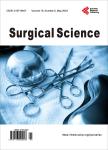Trauma Patient Unplanned Hospital Re-Admissions
Trauma Patient Unplanned Hospital Re-Admissions作者机构:Loyola University Medical Center Maywood Illinois USA
出 版 物:《Surgical Science》 (外科学(英文))
年 卷 期:2012年第3卷第8期
页 面:381-388页
学科分类:1002[医学-临床医学] 100214[医学-肿瘤学] 10[医学]
主 题:Trauma Patients Unplanned Hospital Readmissions Preventable Complications Performance Improvement
摘 要:Introduction: Performance monitoring and performance improvement (PI) are increasingly important. Little is known regarding unplanned re-admission (UPR) in trauma patients. This study characterizes UPRs at one institution. Methods: Retrospective descriptive review of UPR to a Level I Trauma Center Information was obtained on: initial trauma diagnoses, diagnosis precipitating UPR, discharge interval, treatment rendered and length of stay (LOS) during both encounters, and PI committee judgments. Characteristics of UPR patients were determined and compared to those of all discharged patients. Descriptive statistics were applied. Results: Over 2.5 years there were 2827 discharges and 58 UPR(2%). The majority of original diagnoses were related to blunt trauma and head injuries. UPR occurred at a median of 3 days, with 54% re-admitted to the trauma service. Operative rate for UPR patients during the initial admission was 48% with 28%requiring operation on the UPR. Headache and wound issues were responsible for 42% of UPR. Diagnosis precipitating UPR was primarily related to post-operative complications in 26% of all UPR and 57% of those undergoing operation on the initial admission. Median LOS for UPR was 3days with ICU care being required by 13%. Of all UPRs,33% were attributable to opportunities for improved care (OFI) during the first admission. Identified OFIs were related to errors in technique (53%), errors in judgment (27%), and system issues (20%). Of UPR without OFI, 87% were related to disease and13% systems issues. Conclusion: UPR at a Level I trauma center is rare, occurs shortly after discharge, is brief in duration and usually related to postoperative wound issues or headache. Post operative patients seem at greater risk for UPR. While most UPR are considered non-preventable, attention to discharge instructions,patient education, resident education and supervisionand outpatient support, may obviate a number of preventable UPRs.



